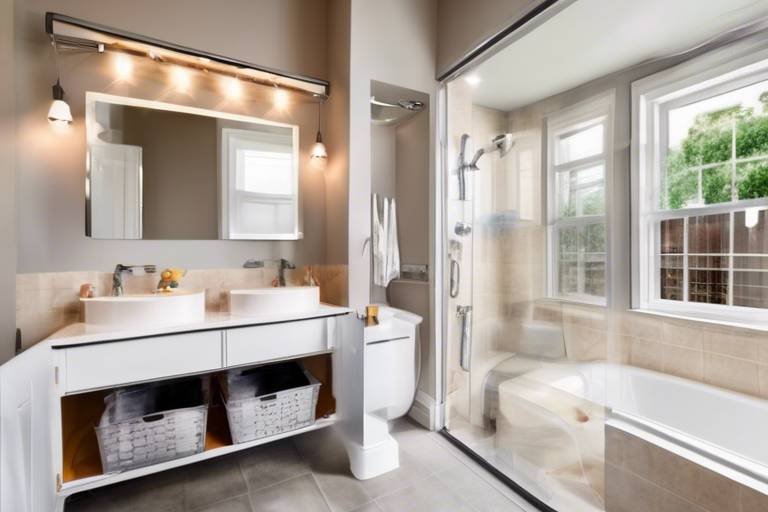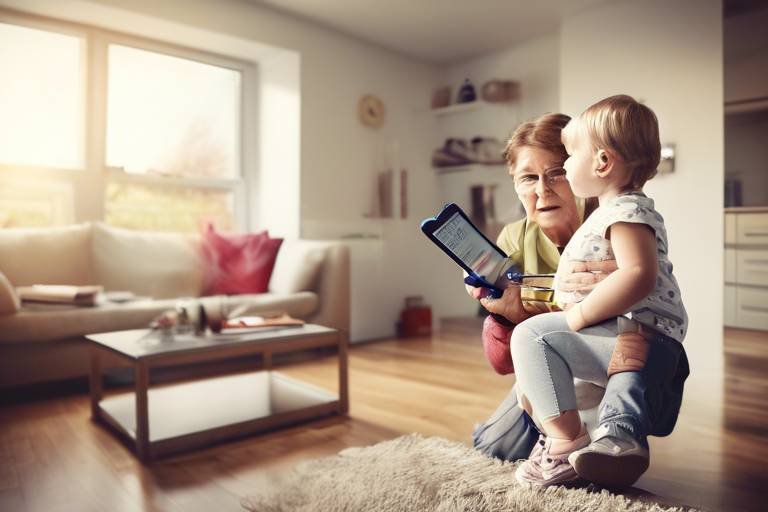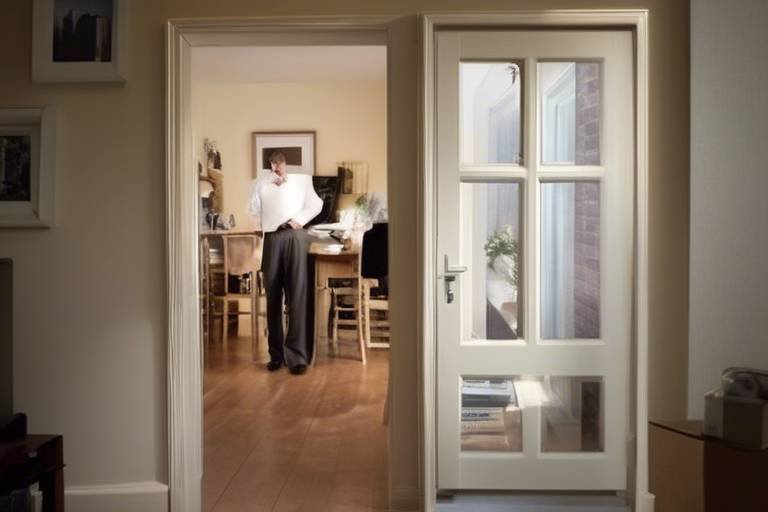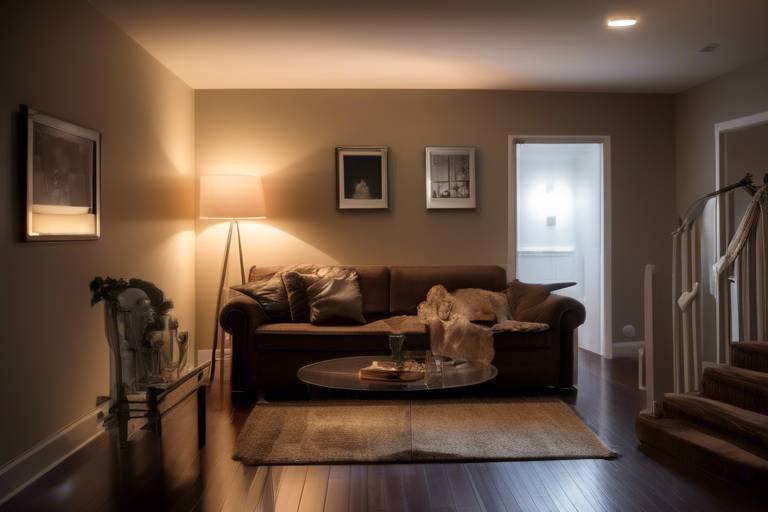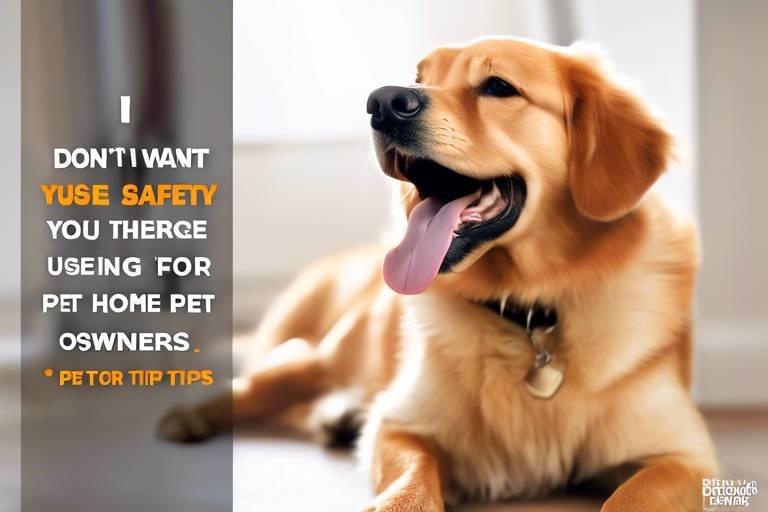Common Mistakes in Home Security Implementation
When it comes to home security, many homeowners often find themselves trapped in a web of common mistakes that can leave their homes vulnerable. It's almost like setting up a fortress but forgetting to close the gates! Understanding these pitfalls can not only enhance your safety but also empower you to take proactive measures against potential threats. In this article, we will explore some frequent errors in home security implementation, providing you with insights that can help you fortify your defenses and protect what matters most.
One of the biggest blunders homeowners make is failing to thoroughly assess their properties for security weaknesses. Think of it this way: if you were a burglar, where would you strike? Identifying vulnerabilities is crucial for implementing effective security measures tailored to specific risks. This can include everything from checking your doors and windows to evaluating the landscaping around your home. For instance, dense bushes can provide cover for intruders, while poorly lit areas can create opportunities for sneaky access. Conducting a comprehensive security assessment can help you pinpoint these weak spots and take action to address them.
Many people underestimate the power of proper outdoor lighting in home security. Imagine walking through a dark alley; it feels risky, right? Well, the same principle applies to your home. Well-lit areas are less inviting for intruders and enhance visibility for you and your neighbors. Installing motion-activated lights around your property can be a game-changer. Not only do they illuminate dark corners, but they also alert you to any unexpected movement. A well-lit home is a welcoming home, but it’s also a fortress that deters unwanted visitors.
Not all locks are created equal, and choosing the wrong one can be like using a paperclip to secure a safe. Homeowners must select high-quality locks that meet security standards to effectively safeguard their entrances against unauthorized access. Look for locks that are certified by organizations such as the American National Standards Institute (ANSI). Remember, a sturdy deadbolt is your first line of defense, and it’s worth investing in high-quality hardware that can withstand tampering.
Smart locks are revolutionizing home security, yet many homeowners overlook their benefits. These advanced devices offer features such as remote access, keyless entry, and activity logs that can enhance both convenience and security. Imagine being able to check if you locked your door from anywhere in the world or giving temporary access to a friend without needing to hand over a physical key. Integrating smart locks into your security system can provide peace of mind and elevate your home’s safety.
When moving into a new home, many homeowners neglect to change the locks, leaving previous owners' keys in circulation. This simple step is vital for ensuring personal safety and preventing unauthorized access. You wouldn’t want strangers having access to your home, would you? Changing the locks is a straightforward yet essential task that can save you from potential headaches down the line.
Alarm systems are only as effective as their maintenance. Just like a car needs regular check-ups, your alarm system requires testing and updates to function optimally. Homeowners should ensure their systems are regularly tested to enhance their effectiveness against potential threats. If your alarm system isn’t functioning properly, it’s like having a fire extinguisher that’s out of service. Stay proactive and make it a habit to check your alarm system frequently.
Many homeowners install security cameras but fail to position them strategically. Proper placement is crucial; it maximizes coverage and effectiveness, providing critical evidence in case of an incident. For instance, placing cameras at entry points like doors and garages can help you monitor who is coming and going. Additionally, consider using cameras with a wide field of view to capture more area. Remember, a camera that doesn’t see the action is just a decorative piece!
Security cameras with poor privacy settings can expose homeowners to risks. It’s essential to understand and configure these settings to maintain privacy while ensuring security. A camera that broadcasts footage to the world is like leaving your front door wide open. Make sure to adjust your camera settings to restrict access to only those who need it, ensuring your home remains a safe haven.
Installing cameras without actively monitoring footage diminishes their effectiveness. Regularly reviewing recorded footage helps identify suspicious activities and enhances overall security awareness. It’s like having a guard dog that you never take outside; it won’t do much good if you don’t utilize it! Set aside time to check your footage, and consider investing in a system that allows for real-time monitoring.
Home security is not solely an individual effort. Engaging with neighbors and local community programs fosters a supportive environment and enhances collective security measures, making neighborhoods safer. You wouldn’t face a storm alone, so why face security threats without your community?
Neighborhood watch programs encourage residents to collaborate on security efforts. Active participation can significantly reduce crime rates and create a sense of community vigilance. It’s like having an extended family that looks out for each other. By joining these programs, you’ll not only contribute to your neighborhood’s safety but also build relationships with those around you.
Exchanging security information among neighbors strengthens overall safety. Sharing resources and tips fosters a culture of awareness, helping everyone stay informed about potential threats. Whether it’s discussing the latest security gadgets or sharing experiences, these conversations can lead to a more secure community. After all, knowledge is power!
- What is the first step in improving home security? Assess your property for vulnerabilities and address them accordingly.
- How important is outdoor lighting? Very important! It deters intruders and enhances visibility.
- Should I change locks when moving into a new home? Yes, always change the locks to ensure your safety.
- How often should I check my alarm system? Regularly, at least every few months, to ensure it’s functioning correctly.
- What are the benefits of smart locks? They offer convenience, remote access, and enhanced security features.

Neglecting to Assess Vulnerabilities
This article explores frequent errors homeowners make when establishing security measures, providing insights to enhance safety and prevent vulnerabilities. Understanding these pitfalls can lead to more effective home security strategies.
When it comes to home security, one of the most significant oversights homeowners make is neglecting to assess their properties for vulnerabilities. Imagine trying to protect your house with a shield that has holes in it; that’s essentially what happens when you skip this crucial step. Identifying vulnerabilities is not just a one-time task; it’s an ongoing process that requires attention to detail and a keen eye for potential risks.
Many homeowners assume that their neighborhoods are safe or that their properties are secure because they have some basic security measures in place. However, failing to conduct a thorough vulnerability assessment can leave you open to threats. Consider the following common areas where vulnerabilities may exist:
- Entry Points: Doors and windows are the primary access points for intruders. Are your locks strong enough? Are the doors solid core?
- Landscaping: Overgrown bushes or trees can provide cover for burglars. Are your plants a hiding spot or a deterrent?
- Lighting: Poorly lit areas around your home can create opportunities for criminal activity. Is your exterior lighting adequate?
To effectively assess vulnerabilities, homeowners should consider conducting a security audit. This involves walking through your home with a critical eye and asking yourself tough questions. Are there areas that are easy to access? Is there anything that could be easily overlooked? By taking the time to evaluate your property, you can identify weak spots and take action to fortify them.
Another aspect to consider is the neighborhood itself. Engaging with neighbors can provide insights into local crime trends and specific vulnerabilities in your area. For instance, if a neighbor recently experienced a break-in, it may indicate a vulnerability that could affect your home as well. By working together, you can create a more secure environment for everyone.
In summary, neglecting to assess vulnerabilities can lead to serious security issues. By being proactive and regularly evaluating your home and its surroundings, you can significantly enhance your home security strategy. Remember, your home is your sanctuary, and taking the time to identify and address vulnerabilities is a critical step in keeping it safe.
Proper outdoor lighting is often underestimated in home security. Well-lit areas deter intruders and enhance visibility, making it an essential component of a comprehensive security strategy.
Not all locks are created equal. Homeowners must select high-quality locks that meet security standards to effectively safeguard their entrances against unauthorized access.
Smart locks offer advanced security features, yet many homeowners overlook their benefits. Understanding how to integrate smart locks can enhance convenience and security simultaneously.
New homeowners often neglect to change locks, leaving previous owners' keys in circulation. This simple step is vital for ensuring personal safety and preventing unauthorized access.
Alarm systems require regular maintenance to function optimally. Homeowners should ensure their systems are regularly tested and updated to enhance their effectiveness against potential threats.
Many homeowners install security cameras but fail to position them strategically. Proper placement maximizes coverage and effectiveness, providing critical evidence in case of an incident.
Security cameras with poor privacy settings can expose homeowners to risks. Understanding and configuring these settings is essential for maintaining privacy while ensuring security.
Installing cameras without actively monitoring footage diminishes their effectiveness. Regularly reviewing recorded footage helps identify suspicious activities and enhances overall security awareness.
Home security is not solely an individual effort. Engaging with neighbors and local community programs fosters a supportive environment and enhances collective security measures, making neighborhoods safer.
Neighborhood watch programs encourage residents to collaborate on security efforts. Active participation can significantly reduce crime rates and create a sense of community vigilance.
Exchanging security information among neighbors strengthens overall safety. Sharing resources and tips fosters a culture of awareness, helping everyone stay informed about potential threats.
Q: How often should I assess my home's vulnerabilities?
A: It's advisable to conduct a vulnerability assessment at least once a year or after any significant changes to your property.
Q: What are the most common vulnerabilities in a home?
A: Common vulnerabilities include weak locks, poor outdoor lighting, and lack of surveillance.
Q: How can I engage my community in security efforts?
A: Start by organizing neighborhood meetings, joining or forming a neighborhood watch program, and sharing security tips.

Overlooking the Importance of Lighting
When it comes to home security, many homeowners often overlook the importance of lighting. It's easy to think that locks and alarm systems are the only things that matter, but let me tell you, lighting is your first line of defense! Imagine walking down a dark street—would you feel safe? Probably not! Well, the same goes for your home. Well-lit areas can act as a deterrent for potential intruders, making it less likely for them to target your property.
Think about it: a well-lit exterior not only enhances the aesthetic appeal of your home but also provides visibility that can thwart criminal activities. In fact, studies show that homes with adequate outdoor lighting are significantly less likely to be burglarized. So, how can you ensure that your property is well-lit? Here are some tips:
- Install Motion-Activated Lights: These lights turn on when they detect movement, startling any unwanted visitors and alerting you to their presence.
- Use Timers: Set your lights on timers to give the appearance that someone is home, even when you're away.
- Highlight Entry Points: Ensure that all entry points, such as doors and windows, are well-lit to eliminate shadows where intruders might hide.
Moreover, consider the different types of lighting. For instance, LED lights are energy-efficient and have a long lifespan, making them a smart choice for outdoor security. You can also opt for solar-powered lights to save on electricity costs while ensuring that your property remains illuminated. The key is to create a well-lit perimeter around your home, which not only enhances your security but also makes your outdoor space more inviting.
In summary, don't underestimate the power of lighting in your home security strategy. It's a simple yet effective way to bolster your defenses. By investing in proper lighting, you can significantly reduce your risk of falling victim to crime, making your home a safer haven for you and your family.

Choosing Inadequate Locks
When it comes to home security, one of the most critical components is the locks on your doors and windows. Unfortunately, many homeowners make the mistake of choosing inadequate locks, often opting for convenience over security. This oversight can leave your home vulnerable to intruders who are all too eager to exploit weak points. It’s essential to understand that not all locks are created equal; some are simply better at keeping unwanted visitors at bay.
Imagine your home as a fortress. The locks are your first line of defense, and just like a castle gate, they need to be strong and reliable. When selecting locks, it’s vital to consider factors such as material quality, locking mechanism, and resistance to tampering. Here are some points to consider:
- Material Quality: Look for locks made from durable materials like hardened steel or brass, which are more resistant to wear and tear.
- Locking Mechanism: Opt for deadbolts or high-security locks that offer more protection than standard spring-latch locks.
- Certification: Check for certification from organizations like ANSI (American National Standards Institute) that rate locks based on their security features.
Additionally, homeowners often overlook the importance of having different types of locks for various entry points. For instance, while a standard lock might suffice for a back door, the front door—which is typically more exposed—should have a stronger, more secure lock. It’s also wise to consider the benefits of smart locks, which not only provide convenience but also come with enhanced security features such as remote access and alerts.
Many homeowners might think that a cheap lock is sufficient, but the cost of a break-in far outweighs the savings on a lock. Investing in high-quality locks can save you from potential heartache and financial loss. Remember, the goal is to make your home as uninviting as possible for intruders. A good lock is like a good alarm system; it works best when it’s reliable and effective.
In conclusion, choosing adequate locks is a fundamental step in ensuring the security of your home. Don’t let the allure of convenience cloud your judgment; instead, invest in locks that provide the peace of mind you deserve. After all, your home is your sanctuary, and it’s worth protecting with the best locks available.
1. What type of lock is the most secure?
The most secure locks are typically deadbolts, especially those that are high-security and certified by ANSI. Smart locks with robust security features can also offer excellent protection.
2. How often should I change my locks?
It’s advisable to change your locks whenever you move into a new home or if you lose your keys. Regularly assessing your locks for wear and tear is also essential.
3. Are smart locks worth the investment?
Yes, smart locks can enhance convenience and security by allowing you to control access remotely and receive alerts about any suspicious activity.
4. Can I install locks myself, or should I hire a professional?
While some homeowners may choose to install locks themselves, hiring a professional ensures that they are installed correctly and securely.

Ignoring Smart Lock Technology
In today's digital age, the **security landscape** is evolving rapidly, and one of the most significant advancements has been the introduction of smart lock technology. Many homeowners still cling to traditional locks, often overlooking the myriad benefits that smart locks can provide. Why would anyone want to stick with outdated methods when modern solutions offer enhanced security and convenience?
Smart locks are designed to integrate seamlessly with your digital lifestyle. They allow you to control access to your home through your smartphone, giving you the ability to lock or unlock your doors from anywhere in the world. Imagine being at work or on vacation and having the ability to let a friend or service provider into your home without needing to be physically present. This level of convenience is not just a luxury; it’s a game-changer for many homeowners.
Moreover, smart locks often come equipped with advanced features that traditional locks simply can't match. For instance, many smart locks offer:
- Keyless Entry: No more fumbling for keys or worrying about losing them. You can enter your home using a code or your smartphone.
- Temporary Access Codes: Need to give a friend access while you're away? Create a temporary code that expires after a certain time.
- Activity Logs: Keep track of who enters and exits your home with detailed logs that provide insights into your household's activity.
However, despite these advantages, many homeowners hesitate to adopt smart lock technology due to concerns about security and complexity. It's essential to understand that reputable smart locks come with robust encryption and security features designed to protect against unauthorized access. Additionally, the setup process is often straightforward, with many manufacturers providing user-friendly apps to guide you through installation and configuration.
Ignoring smart lock technology not only means missing out on these benefits but also leaves your home vulnerable to potential security breaches. In a world where home security is paramount, embracing this innovation can significantly enhance your safety. So, why not take the plunge and explore how smart locks can revolutionize your home security?
Q: What happens if I lose my smartphone?
A: Most smart locks have backup options, such as a physical key or a keypad, allowing you to access your home even if your smartphone is lost.
Q: Are smart locks easy to install?
A: Yes, many smart locks are designed for easy installation, often requiring just a few tools and minimal technical knowledge. Some models even offer a DIY installation option.
Q: Can I monitor who enters my home with a smart lock?
A: Absolutely! Many smart locks come with features that allow you to view access logs, showing you who entered and when.
Q: Do smart locks work during power outages?
A: Most smart locks operate on batteries, so they will continue to function even during a power outage, ensuring you always have access to your home.
Q: Are smart locks compatible with home automation systems?
A: Yes, many smart locks can be integrated with home automation systems, allowing for enhanced control and security features.

Failing to Change Locks After Moving In
When you step into your new home, the excitement can be overwhelming. However, in the midst of unpacking boxes and dreaming about decorating, many homeowners forget a crucial step: changing the locks. This simple action can be the difference between feeling secure and inviting potential risks. Think about it—when you buy a home, you have no idea how many keys are still floating around from previous owners, family members, or even contractors who worked on the property. It’s like leaving the front door wide open and hoping for the best!
Changing the locks is not just a precaution; it’s a fundamental part of establishing your new space as your own. Imagine walking into your home, feeling confident that no one else has access to your sanctuary. This peace of mind is invaluable. To make the process easier, consider the following:
- Assess Your Current Locks: Before you decide to change them, take a moment to evaluate the condition of your locks. Are they rusty? Do they function smoothly? If not, it’s time for an upgrade.
- Choose High-Quality Locks: Not all locks are created equal. Opt for locks that meet industry security standards to effectively safeguard your entrances.
- Consider Smart Locks: If you’re tech-savvy, smart locks can offer enhanced security features, allowing you to control access through your smartphone.
Moreover, changing locks isn’t a task that requires a locksmith every time. Many homeowners take the DIY route, which can be both cost-effective and satisfying. Just ensure you have the right tools and follow the instructions carefully. However, if you’re not confident in your abilities, hiring a professional is always a wise choice.
In summary, neglecting to change the locks after moving in is a mistake that can lead to serious security vulnerabilities. Take this simple yet essential step to ensure that your new home is truly yours, free from the shadows of past occupants. Remember, it’s better to be safe than sorry!
Q: How often should I change my locks?
A: It’s a good idea to change your locks when you move into a new home, and consider rekeying or changing them every few years or after significant life changes.
Q: Can I change my locks myself?
A: Yes! Many homeowners successfully change their own locks. Just make sure you have the right tools and follow the manufacturer’s instructions.
Q: What type of locks should I choose for my home?
A: Look for locks that are rated for security, such as deadbolts or smart locks, which offer additional features like remote access and alerts.

Disregarding Alarm System Maintenance
When it comes to home security, many homeowners have a tendency to set it and forget it. They invest in an alarm system, feel a sense of relief, and then promptly ignore it. This is a critical mistake! Just like a car needs regular oil changes and maintenance checks, your alarm system requires consistent attention to ensure it functions optimally. Think of your alarm system as the guardian of your home; if it’s not well-maintained, it can’t protect you effectively.
Regular maintenance of your alarm system is essential for several reasons. First, technology can sometimes fail. If you haven’t tested your alarm system in months, how do you know it will work when you need it most? Regular checks can help identify any issues before they become significant problems. For instance, battery failures or faulty sensors can go unnoticed without routine inspections, leaving your home vulnerable.
Moreover, alarm systems often come with software that requires updates. These updates can include important security patches that protect against new threats. By neglecting to update your system, you may be leaving the door wide open for intruders who exploit outdated technology. Therefore, it's crucial to stay proactive and ensure that your system is up to date with the latest features and security measures.
So, what should you do to maintain your alarm system? Here are a few tips:
- Schedule Regular Inspections: Aim for at least once a year, but bi-annual checks are even better.
- Test Your System: Regularly test your alarm to ensure all sensors and alarms are functioning correctly.
- Replace Batteries: Change batteries in your sensors and control panel as needed, typically every 6-12 months.
- Stay Informed: Keep an eye on updates from your alarm system provider and apply them promptly.
By following these simple yet effective maintenance steps, you can ensure that your alarm system remains a reliable line of defense for your home. After all, a well-maintained alarm system is not just a luxury; it's a necessity in today's world where security threats are ever-evolving.
Q: How often should I test my alarm system?
A: It's recommended to test your alarm system at least once a month to ensure everything is functioning properly.
Q: What should I do if my alarm system goes off accidentally?
A: If your alarm goes off, check to see if there is a legitimate threat. If it’s a false alarm, reset the system and investigate what caused it. If it happens frequently, consider consulting a professional.
Q: Can I maintain my alarm system myself?
A: Yes, many basic maintenance tasks such as testing and battery replacement can be done by homeowners. However, for more complex issues, it's best to consult a professional.
Q: What happens if I don't maintain my alarm system?
A: Neglecting maintenance can lead to system failures, leaving your home vulnerable to break-ins and other security threats.

Not Using Security Cameras Effectively
When it comes to home security, one of the most powerful tools at your disposal is a security camera. However, simply installing them is not enough; many homeowners fall into the trap of . Imagine having a high-tech gadget that could provide peace of mind, yet failing to utilize it to its full potential. It's like having a state-of-the-art alarm system but forgetting to set it at night!
One of the biggest mistakes is poor camera placement. Think about it: if your camera is pointing at a blank wall or a tree, what good is it? The effectiveness of security cameras hinges on their strategic positioning. Ideally, cameras should cover all entry points, including doors and windows, as well as high-traffic areas around your property. A well-placed camera can serve as a deterrent, making intruders think twice before attempting to breach your home. To maximize coverage, consider the following tips:
- Install cameras at eye level to capture clear images of faces.
- Aim for a wide field of view to monitor larger areas.
- Ensure cameras are weatherproof and suitable for outdoor use.
Another common oversight is the failure to monitor the footage actively. It's not enough to just set up the cameras and forget about them. Regularly reviewing recorded footage is crucial for spotting suspicious activities and understanding patterns around your home. Think of it as keeping an eye on your surroundings; you wouldn't ignore a strange person hanging around your neighborhood, right? By actively monitoring footage, you can enhance your overall security awareness and respond quickly to any potential threats.
Moreover, many homeowners underestimate the importance of privacy settings on their security cameras. If these settings are not configured correctly, you might inadvertently expose yourself to risks. For instance, if your camera is streaming live footage without proper encryption, it could be hacked, putting your privacy at risk. Always take the time to understand and adjust your camera's privacy settings to ensure that your footage is secure. This is especially important in an age where cyber threats are rampant.
Lastly, consider integrating your security cameras with a comprehensive home security system. This means linking them to alarms, motion detectors, and even smart home devices. This interconnectedness not only enhances your security but also allows for real-time alerts. Imagine receiving a notification on your phone when motion is detected in your yard, allowing you to take immediate action. This level of responsiveness can be crucial in preventing a potential break-in.
In conclusion, while security cameras are an essential component of home security, their effectiveness relies heavily on proper usage. By ensuring strategic placement, actively monitoring footage, configuring privacy settings, and integrating them with other security measures, you can significantly enhance your home’s safety. Remember, a well-utilized security camera is not just a piece of technology; it's a guardian watching over your home, ready to alert you to any danger.
Q: How many security cameras do I need for my home?
A: The number of cameras you need depends on the size of your property and the areas you want to cover. Generally, it's advisable to cover all entry points and any blind spots.
Q: Can I monitor my security cameras remotely?
A: Yes, most modern security cameras come with mobile apps that allow you to monitor your footage in real-time from anywhere.
Q: What should I do if I notice suspicious activity on my camera?
A: If you see suspicious activity, it's best to contact local authorities immediately and avoid confronting any potential intruders yourself.
Q: How can I ensure my security camera footage is secure?
A: Make sure to change default passwords, use encryption, and regularly update your camera's firmware to protect against hacking.

Ignoring Privacy Settings
When it comes to home security, one crucial aspect that often gets overlooked is the privacy settings of security cameras. Many homeowners invest in high-tech surveillance systems, thinking they’ve taken the ultimate step towards safeguarding their homes. However, failing to configure privacy settings can expose them to significant risks. Imagine setting up a security camera to protect your home, only to discover that it broadcasts sensitive information to the public or, worse, allows unauthorized access to your footage. This scenario is more common than you might think.
Most security cameras come with a range of privacy features designed to enhance your security. These features can include options to limit who can view the camera feed, settings to blur certain areas from view, or even the ability to disable recording during specific hours. Ignoring these settings can leave you vulnerable, as intruders might exploit any gaps in your security. For instance, if your camera is positioned in a way that captures not just your property but also your neighbor's yard or the street, you could inadvertently be violating their privacy, leading to potential legal issues.
Moreover, many security systems offer cloud storage for recorded footage. While this can be incredibly beneficial, it also poses a risk if not managed correctly. If your account is not secured with a strong password or two-factor authentication, hackers could gain access to your stored videos, potentially using them for malicious purposes. Therefore, it's essential to not only set up your cameras but also to regularly review and update your privacy settings.
To help you understand the importance of privacy settings, consider the following key points:
- Access Control: Ensure that only trusted individuals have access to your camera feeds. Use strong, unique passwords and enable two-factor authentication whenever possible.
- Area Restrictions: Utilize features that allow you to restrict the view of certain areas, ensuring that your camera focuses only on your property.
- Regular Monitoring: Frequently check your camera settings and footage to ensure that everything is functioning as intended and that no unauthorized changes have been made.
In conclusion, taking the time to configure and regularly review your security camera privacy settings can significantly enhance your home security. By being proactive and informed, you can ensure that your surveillance system works effectively without compromising your privacy or that of your neighbors. Remember, in the world of home security, being vigilant is just as important as having the right technology in place.
Q1: What are privacy settings on security cameras?
Privacy settings are features that allow you to control who can view your camera feeds and what areas of your property are recorded. Properly configuring these settings helps protect your privacy and that of others.
Q2: How can I secure my camera footage?
To secure your camera footage, use strong passwords, enable two-factor authentication, and regularly check your privacy settings to ensure they are up-to-date.
Q3: What should I do if I suspect my camera has been hacked?
If you suspect your camera has been hacked, immediately change your passwords, review your privacy settings, and consider contacting the manufacturer for further assistance.

Failing to Monitor Footage
This article explores frequent errors homeowners make when establishing security measures, providing insights to enhance safety and prevent vulnerabilities. Understanding these pitfalls can lead to more effective home security strategies.
Many homeowners fail to thoroughly assess their properties for security weaknesses. Identifying vulnerabilities is crucial for implementing effective security measures tailored to specific risks.
Proper outdoor lighting is often underestimated in home security. Well-lit areas deter intruders and enhance visibility, making it an essential component of a comprehensive security strategy.
Not all locks are created equal. Homeowners must select high-quality locks that meet security standards to effectively safeguard their entrances against unauthorized access.
Smart locks offer advanced security features, yet many homeowners overlook their benefits. Understanding how to integrate smart locks can enhance convenience and security simultaneously.
New homeowners often neglect to change locks, leaving previous owners' keys in circulation. This simple step is vital for ensuring personal safety and preventing unauthorized access.
Alarm systems require regular maintenance to function optimally. Homeowners should ensure their systems are regularly tested and updated to enhance their effectiveness against potential threats.
Many homeowners install security cameras but fail to position them strategically. Proper placement maximizes coverage and effectiveness, providing critical evidence in case of an incident.
Security cameras with poor privacy settings can expose homeowners to risks. Understanding and configuring these settings is essential for maintaining privacy while ensuring security.
Installing security cameras is only half the battle; can significantly undermine your home security efforts. Picture this: you've invested in high-quality cameras, but if you're not regularly reviewing the recordings, you're essentially leaving your front door wide open for trouble. It's like having a guard on duty who never looks up from their phone!
To maximize the effectiveness of your security system, it's crucial to develop a routine for monitoring the footage. This doesn't mean you need to sit glued to your screen all day, but setting aside a few minutes each week can help you spot any suspicious activities or patterns. Consider the following:
- Review Recorded Footage: Regularly check for any unusual activity that may have been recorded.
- Set Alerts: Many modern systems allow you to set alerts for specific movements or times, so you can focus on the most critical moments.
- Document Incidents: If you do spot something suspicious, make sure to document it. This can be invaluable if you need to report it to the police.
Moreover, consider the technology at your disposal. Many security systems come equipped with advanced features like motion detection and cloud storage, which can make monitoring a breeze. By leveraging these tools, you can enhance your overall security strategy without adding to your workload.
In essence, neglecting to monitor your security camera footage is like having a lifeguard who never watches the pool. You need to be proactive, not reactive, to keep your home safe and sound.
Home security is not solely an individual effort. Engaging with neighbors and local community programs fosters a supportive environment and enhances collective security measures, making neighborhoods safer.
Neighborhood watch programs encourage residents to collaborate on security efforts. Active participation can significantly reduce crime rates and create a sense of community vigilance.
Exchanging security information among neighbors strengthens overall safety. Sharing resources and tips fosters a culture of awareness, helping everyone stay informed about potential threats.
If you notice anything unusual, document it and report it to local law enforcement. It's better to be safe than sorry!
It's advisable to review your footage at least once a week. However, if your system has alert features, you can focus on those specific times.
Absolutely! Smart locks offer added convenience and security features that traditional locks can't match.
Common vulnerabilities include poorly lit areas, weak locks, and unmonitored entry points. Regular assessments can help identify these risks.

Underestimating the Value of Community Engagement
When it comes to home security, many homeowners tend to think of their property as an isolated fortress, a realm where they can protect their loved ones and belongings from external threats. However, this perspective can be misleading. In reality, effective home security extends far beyond the boundaries of your property lines. One of the most significant yet often overlooked aspects is the importance of community engagement. Building relationships with your neighbors and participating in local safety initiatives can create a network of support that enhances overall security.
Think of your neighborhood as a living organism, where each home represents a vital organ working together to maintain health and safety. When individuals engage with one another, they foster a sense of community vigilance, which can act as a powerful deterrent against crime. Consider this: when neighbors know each other, they are more likely to look out for one another. They notice unusual activities, report suspicious behavior, and create a culture of accountability. This collective awareness can significantly reduce the chances of criminal activity, as intruders are less likely to target an area where residents are actively engaged and watchful.
Moreover, community engagement can take many forms. For instance, participating in neighborhood watch programs is one of the most effective ways to foster a sense of security. These programs encourage residents to collaborate on security efforts, share information, and keep an eye on each other's properties. The simple act of knowing your neighbors can lead to a more connected and safer environment. In fact, studies have shown that neighborhoods with active watch programs experience lower crime rates compared to those without.
Additionally, sharing security tips and resources among neighbors can amplify the effectiveness of individual security measures. When residents exchange information about the latest security technologies, local crime trends, or even personal experiences, it creates a wealth of knowledge that everyone can benefit from. For example, if one neighbor discovers a new home security system that works wonders, they can recommend it to others, ensuring that the entire community is better protected. This collaborative approach not only enhances safety but also builds trust and camaraderie among residents.
In essence, community engagement is about creating a safety net that extends beyond your front door. It’s about recognizing that we are all in this together, and that by working collectively, we can create a more secure environment for everyone. So, the next time you think about enhancing your home security, don’t forget to look beyond your own walls. Engage with your neighbors, participate in community programs, and foster a culture of awareness. After all, a strong community is the best defense against crime.
- How can I get involved in my community's safety initiatives? Start by attending local neighborhood meetings or reaching out to community organizations focused on safety.
- What are the benefits of joining a neighborhood watch program? Joining a neighborhood watch can help reduce crime, foster relationships with neighbors, and increase overall community awareness.
- How can I effectively share security tips with my neighbors? Organize casual meetings or create a group chat to discuss security strategies and share resources.

Participating in Neighborhood Watch Programs
Participating in neighborhood watch programs is not just a good idea; it's a game changer for community safety. Think of it as a collective shield against crime, where neighbors unite to keep an eye on each other's homes. When you join forces with your neighbors, you create a network of vigilance that can deter potential criminals. After all, a well-informed community is a safer community.
One of the best aspects of neighborhood watch programs is that they foster a sense of belonging. Imagine walking down your street and knowing your neighbors by name, sharing a friendly wave, and feeling secure in the knowledge that you're all looking out for one another. This camaraderie not only enhances safety but also builds lasting relationships. When everyone is engaged, the community becomes a fortress against crime.
Moreover, neighborhood watch programs often provide training and resources on how to recognize suspicious behavior and report it effectively. This education empowers residents to take action without putting themselves in harm's way. For instance, you might learn how to identify the signs of a potential break-in or how to report a suspicious vehicle parked for too long. These skills are invaluable and can make a significant difference in your neighborhood's safety.
Additionally, many neighborhood watch programs collaborate with local law enforcement agencies. This partnership can lead to improved communication and quicker responses to incidents. When police officers know the community well, they can be more effective in their patrols and interventions. It's like having a direct line to your local law enforcement, making you feel more secure.
In essence, participating in a neighborhood watch program is about more than just crime prevention; it's about creating a supportive environment. By coming together, you can share security tips, resources, and even organize community events that promote safety awareness. Some neighborhoods even host block parties to celebrate their commitment to security and community spirit. This not only strengthens bonds but also makes it clear to potential intruders that the area is well-monitored and cared for.
So, if you haven't already, consider joining or starting a neighborhood watch program in your area. It’s a simple step that can lead to profound changes in your community's safety. Remember, the more eyes on the street, the safer everyone feels.
- What is a neighborhood watch program?
A neighborhood watch program is a community initiative where residents come together to monitor and report suspicious activities in their neighborhood, enhancing overall safety. - How can I start a neighborhood watch program?
To start a neighborhood watch program, gather interested neighbors, contact your local law enforcement for guidance, and organize meetings to discuss safety strategies. - Are neighborhood watch programs effective?
Yes, research shows that neighborhoods with active watch programs often experience lower crime rates due to increased vigilance and community engagement. - What should I do if I notice suspicious activity?
If you see something suspicious, report it to your local law enforcement agency immediately, providing as much detail as possible.

Sharing Security Tips and Resources
In our fast-paced world, with neighbors can be a game changer for home safety. Imagine living in a community where everyone is vigilant and informed; it’s like having a built-in security system! When homeowners exchange valuable information, they not only bolster their own safety but also create a network of support that enhances the security of the entire neighborhood.
One effective way to share security tips is through informal gatherings or neighborhood meetings. These get-togethers can be a great platform for discussing recent incidents, sharing personal experiences, and recommending security products or services. For instance, if someone had a positive experience with a local locksmith or security system provider, sharing that information can save others time and money.
Additionally, using social media platforms or community apps can facilitate ongoing communication. Creating a dedicated group where residents can post alerts about suspicious activities, share safety tips, or recommend local resources can significantly enhance community awareness. For example, if a neighbor notices an unfamiliar vehicle parked for an extended period, they can quickly alert the group, allowing everyone to stay informed and vigilant.
Moreover, consider organizing a workshop on home security. This could involve inviting a local police officer or security expert to discuss best practices, answer questions, and provide demonstrations on how to use various security devices effectively. Such events not only educate but also foster a sense of community and shared responsibility.
To further illustrate the importance of sharing resources, here’s a simple table showcasing some practical tips and resources that can be shared among neighbors:
| Tip/Resource | Description | How to Share |
|---|---|---|
| Local Security Services | Recommendations for trusted locksmiths and alarm system providers. | Community meetings, social media groups. |
| Emergency Contacts | List of local emergency numbers and neighborhood watch contacts. | Flyers, community bulletin boards. |
| Safety Protocols | Guidelines on how to report suspicious behavior and what to do in emergencies. | Workshops, neighborhood newsletters. |
In conclusion, sharing security tips and resources is not just a good idea; it’s a vital part of creating a safer living environment. By fostering open communication and collaboration among neighbors, we can significantly reduce risks and enhance our collective security. Remember, a well-informed community is a safe community!
Q: How can I start sharing security tips with my neighbors?
A: You can begin by organizing a casual meet-up or creating a group on social media where everyone can share their experiences and recommendations.
Q: What should I include in a neighborhood security workshop?
A: Consider including topics like home security basics, how to use security devices, and local crime statistics. Inviting a local law enforcement officer can also provide valuable insights.
Q: Are there any online platforms specifically for neighborhood security discussions?
A: Yes, platforms like Nextdoor or Facebook groups can be excellent for sharing security concerns and tips with your local community.
Frequently Asked Questions
- What are the common vulnerabilities in home security?
Many homeowners overlook vulnerabilities such as weak locks, poor lighting, and unmonitored security systems. It’s essential to assess your property thoroughly to identify these weak points and implement appropriate security measures.
- How important is outdoor lighting for home security?
Outdoor lighting is crucial! Well-lit areas act as a deterrent to intruders, making it harder for them to approach unnoticed. Consider installing motion-activated lights to enhance visibility around your home.
- What types of locks should I use for better security?
Opt for high-quality locks that meet recognized security standards. Deadbolts, smart locks, and high-security locks provide better protection against unauthorized access than standard locks.
- Why should I consider smart locks?
Smart locks offer advanced features such as remote access, keyless entry, and alerts for unauthorized access attempts. They combine convenience with enhanced security, making them a smart choice for modern homeowners.
- Should I change the locks when I move into a new home?
Absolutely! Changing the locks is a simple yet effective way to ensure your safety. Previous owners may still have keys, so this step is crucial to prevent unauthorized access.
- How often should I maintain my alarm system?
Your alarm system should be tested regularly—at least once a year. Regular maintenance ensures that it functions optimally and is ready to protect you in case of an emergency.
- What should I consider when installing security cameras?
Placement is key! Ensure that cameras cover all entry points and blind spots. Additionally, familiarize yourself with privacy settings to protect your personal information while enhancing security.
- How can I effectively monitor security camera footage?
Make it a habit to review footage regularly. This practice helps you spot suspicious activities and keeps you aware of what's happening around your home, ultimately enhancing your security awareness.
- Why is community engagement important for home security?
Home security is a team effort! Engaging with neighbors through programs like Neighborhood Watch fosters a supportive environment, making your community safer and more vigilant against crime.
- How can I participate in neighborhood security efforts?
Join local Neighborhood Watch programs or community meetings. Sharing security tips and resources with your neighbors strengthens overall safety and creates a culture of awareness in your area.


